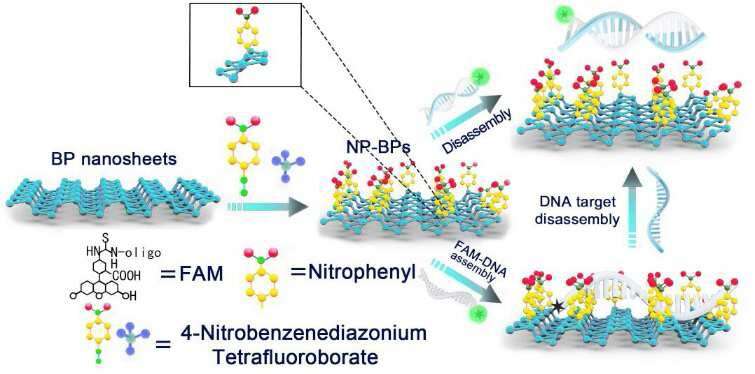Schematic design of NP-BPs-based biosensor for ctDNA detection. Credit: SIAT
Circulating tumor DNA (ctDNA) refers to DNA found in the bloodstream that comes from cancerous cells and tumors. CtDNA identification is one of the most meaningful approaches to early cancer diagnosis. However, there are few effective and practical methods for analyzing this emerging class of biomarkers.
Researchers from the Shenzhen Institutes of Advanced Technology (SIAT) of the Chinese Academy of Sciences have fabricated novel black phosphorus (BPs) nanosheets for sensitive and selective detection of ctDNA.
In the study published in Biosensors and Bioelectronics, the researchers developed a nitrophenyl functionalized black phosphorus nanosheet (NP-BPs) biosensor based on the discrimination ability of single-stranded DNA (ssDNA) / double-stranded (dsDNA).
Due to the nitrophenyl functionalization, the NP-BPs biosensor synergistically increased the stability of BPs and enhanced hydrophobic and π-π stacking interactions between the biosensor and nucleotide bases, providing specific detection of ctDNA.
This biosensor showed advantages in ctDNA detection with an excellent sensitivity of 50 fM and a wide linear detection range of 50 fM-80 pM.
In addition to robustness and specificity in the discrimination of single nucleotide polymorphisms, the NP-BPs biosensor accurately detected ctDNA in the clinical serum samples. Notably, the detection process was simple with good reproducibility, and only took 15 minutes.
The researchers believe that the NP-BPs-based sensing platform is promising for early cancer diagnosis and monitoring cancer progression.
More information: Chi Huang et al. Sensitive and selective ctDNA detection based on functionalized black phosphorus nanosheets, Biosensors and Bioelectronics (2020). DOI: 10.1016/j.bios.2020.112384
Journal information: Biosensors and Bioelectronics
Provided by Chinese Academy of Sciences
























